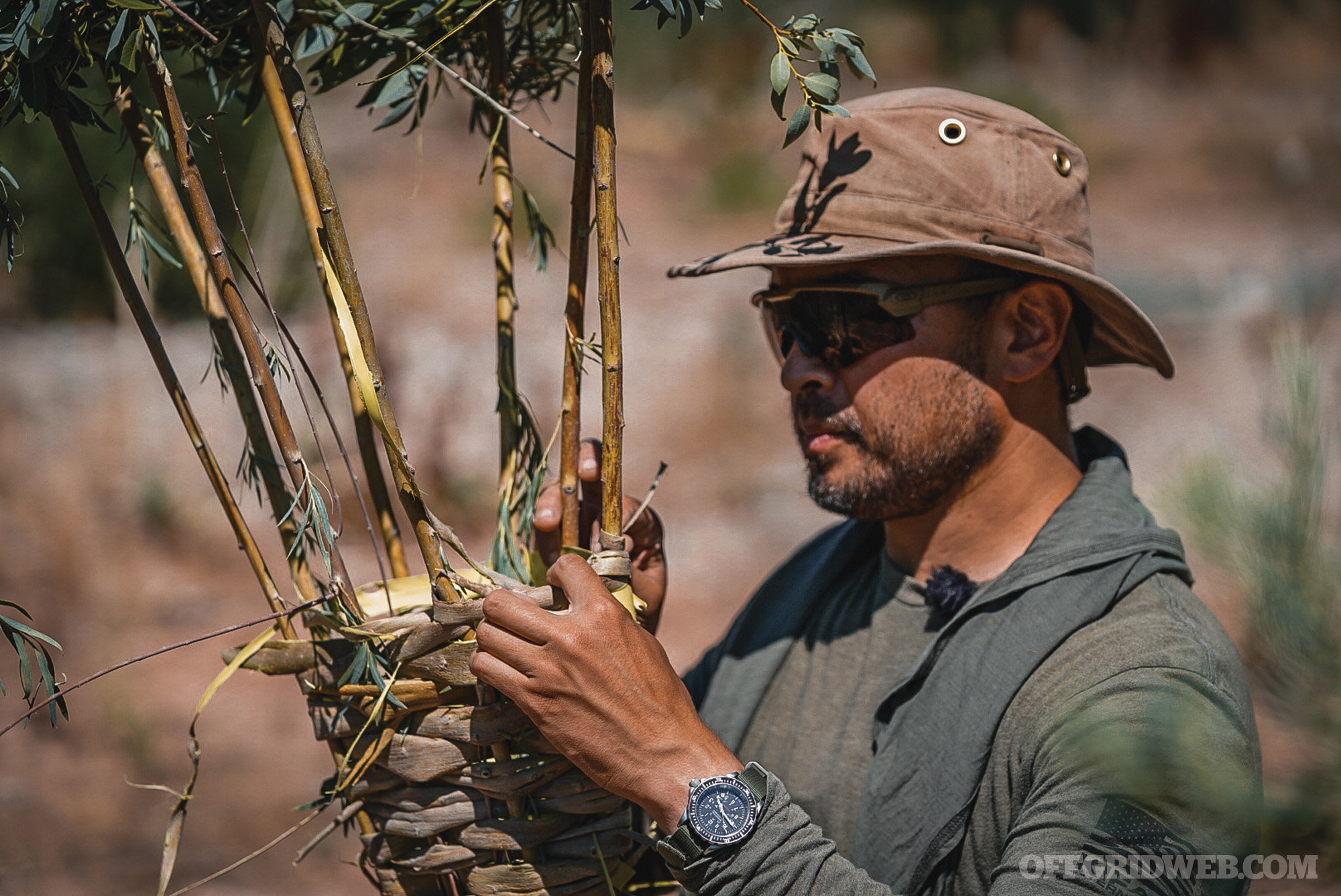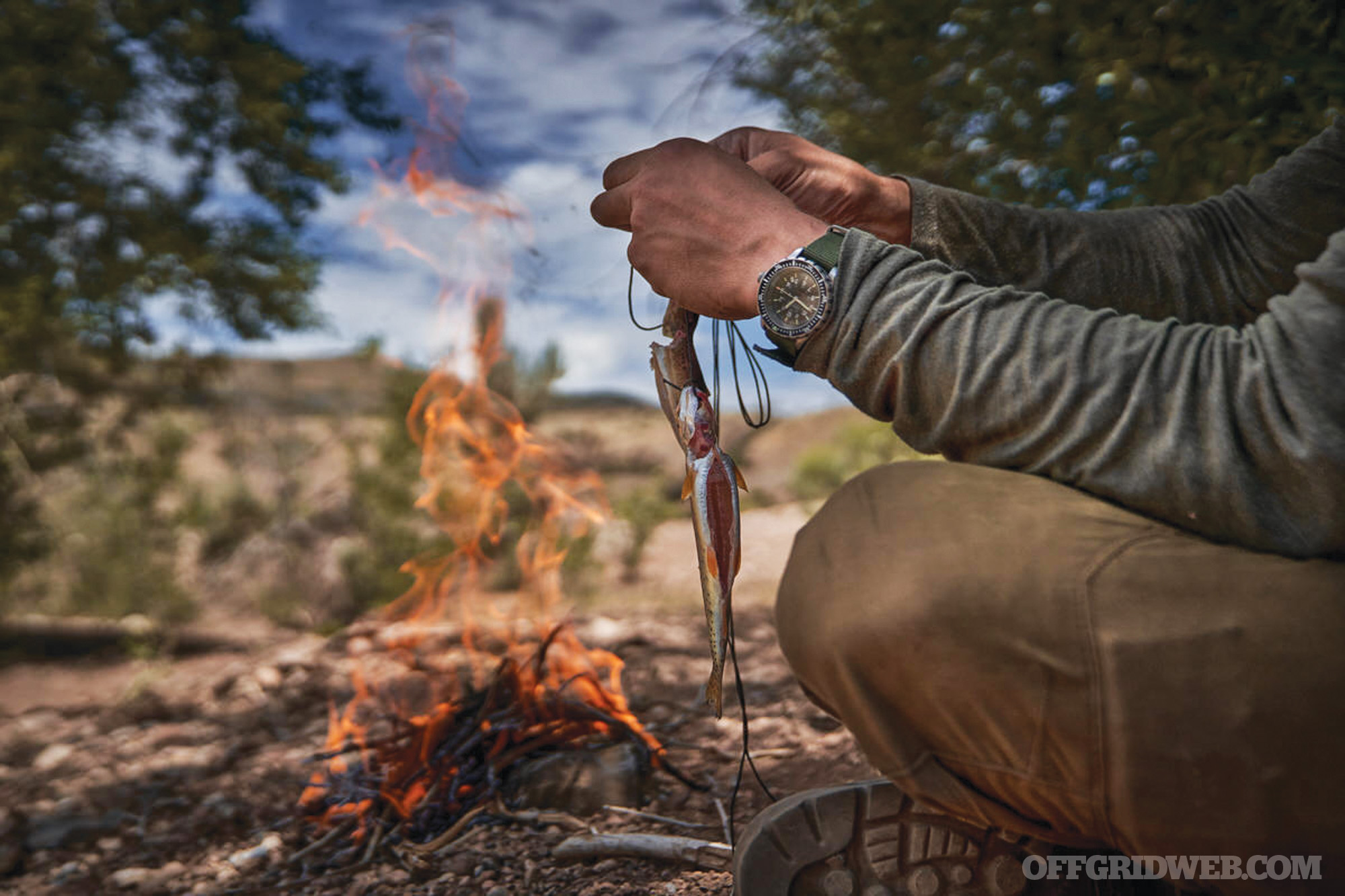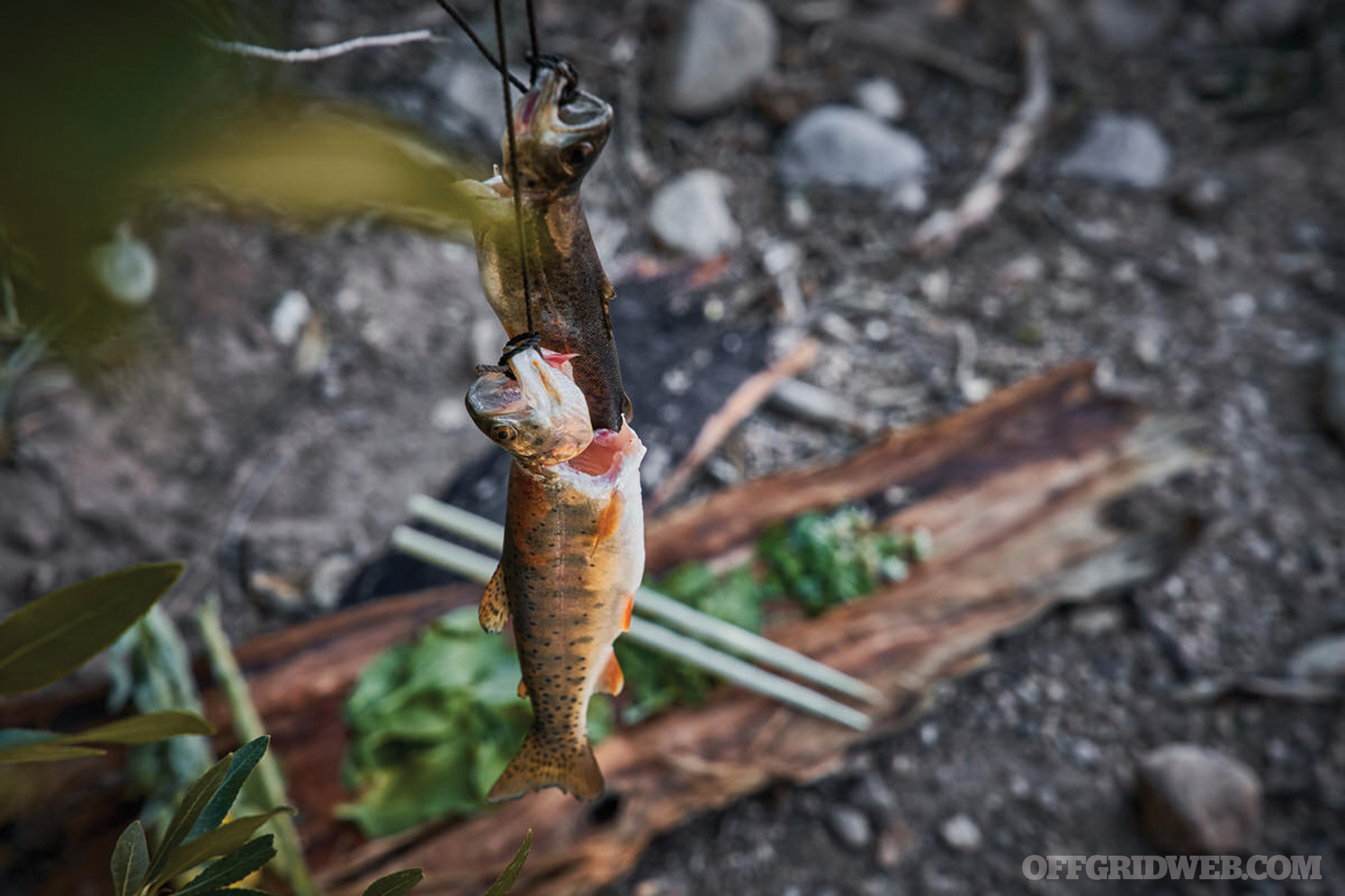Working for Fieldcraft Survival, I’ve learned to expect each day to be filled with the unexpected. We have a highly dynamic work environment with new projects and tasks on a regular basis. One day, we’re scouting land for upcoming courses, the next we’re flying to another state to teach a defensive handgun class, the next we’re filming online content in the mountains — you get the idea.
The Fieldcraft Survival Challenge
In June 2021, my boss Mike Glover challenged me to survive for 72 hours in the desert with nothing more than the contents of a quart-sized Ziploc bag. Since I was hired to be the lead survival subject matter expert, I wasn’t going to pass up this opportunity.
Above: The gear the author was allowed to carry needed to fit inside a closed 1-quart plastic bag.
Statistically speaking, most emergencies last no more than 72 hours. Within those 72 hours, a person can self-rescue, problem solve, and affect their situation to prevent the emergency from becoming a survival scenario. There’s no doubt anyone can be thrust into an emergency bivouac or short-term emergency in their day-to-day travels. In an unfortunate circumstance like that, the contents of one’s pockets or a small emergency kit may be the only gear available. Pocket gear will generally not take up more space than what can fit into a quart-sized Ziploc bag. Hypothetically, a person should be able to survive 72 hours in a given environment with a quart-sized kit designed to address basic survival needs. Hypotheticals are good for debate, but practical exercises are better for proof. I recently took a single Ziploc to the high desert and survived triple-digit heat and gained many teachable points to share here.
Disclaimer: This 72-hour survival challenge was performed by a professional survival instructor under close supervision by rescue personnel. Do not attempt any potentially dangerous survival challenge without prior training, and always establish contingency plans in case something goes wrong.
Planning the Ziploc Bag Kit
Above: Kevin Estela is the Director of Training for Fieldcraft Survival, with over two decades of outdoor skill teaching experience. He drew upon his edible plant knowledge to sustain himself for the 72-hour challenge.
Mission always dictates gear. Surviving 72 hours in the high desert of Utah during the hottest month of the year meant shifting survival priorities around. Deciding whether shelter or water is priority number one is conditional on clothing and existing makeshift structures like a broken-down vehicle. Since this challenge required using the contents of the Ziploc, I carried a North American Rescue Emergency Wrap blanket to sleep under and an Adventure Medical Kits 1-Person Bivy to sleep inside of. In terms of water, I premeasured and marked 24 ounces on a collapsible bladder for easy use with Aquatabs. Aquatabs call for 1/10 gallons or 25 ounces and even if I were off by 1 ounce on my water collection, the tabs would work as expected.
Given the fire restrictions in the area, I packed some basics just for proof of concept including a Mini-BIC, Exotac nanoSTRIKER ferro rod, and some premade tinder. Cordage was carefully chosen with emphasis on smaller “disposable” cordage as a space-saver. Duct tape and superglue rounded out the kit for multipurpose use in binding and first-aid. Nutrition was a serious consideration in this challenge. Since most people carry plenty of food stores on their body in the form of fat, I knew I could go longer than 72 without food. That said, I didn’t want to compromise my health. I packed a sleep aid, multi-vitamins, and rehydration tablets. Part of the challenge was an allowance of reasonable clothing. I couldn’t pack a puffy jacket just for sleeping at night if I wouldn’t normally wear it. This meant a pair of pants, boxers, a long-sleeve T-shirt, button-up shirt, wide-brim hat, sunglasses, neckerchief/scarf, and boots. I didn’t carry a spare set of socks, and I didn’t have gloves for hand protection with me.
Another thing worth noting is the large safety net the Fieldcraft Survival team cast for this challenge. I was monitored by our medic Austin Lester and I carried a small Kifaru Escape and Evasion Pack filled with an emergency medical kit, short-wave radio, electrolyte drink, Kestrel device for taking weather readings, and battery packs to recharge my electronics used to update social media. I had an emergency trailer about a quarter mile from my location I wasn’t allowed to enter, as well as my vehicle nearby. I had to remain in the environment on 2,500 acres of private land and not use the emergency provisions unless they were absolutely necessary. This type of challenge is very rewarding to the participant, but it can be dangerous if precautions aren’t in place.
Ziploc Bag Contents
Shelter:
- North American Rescue Rescue Wrap
- Stay Outside Longer (SOL) Emergency Bivy Sack
Water:
- Fieldcraft Survival Collapsible Bladder
- Reynolds Oven Bags
- 3-Foot Vinyl Tubing
- 30 Aquatabs
Fire:
- Mini BIC lighter
- Exotac nanoSTRIKER
- 4x Procamptek Tinder Plugs
Knives:
- Victorinox Farmer
- ESEE Knives S35VN Izula With Duct-Tape Edge Guard
Cordage and Utility:
- 6-Foot Duct Tape
- 12.6 Feet 550 Paracord
- 25-Foot Braided Tarred Catahoula Line
- 3-Foot Stainless Steel Wire
- 1x Single Use Superglue
- 2x Small Cable Ties
- 1x Button Compass
- 1x Quart-Size Ziploc
Fishing and “Hunting”:
- Assorted Dry Flies
- 6-Foot 4x Fly-Fishing Tippet
- 25-Foot 50-Pound Test Spiderwire
- Assorted Hooks, Split Shot, Snap Swivels
- 2x Sheffield Floats
- 1x Theraband Slingshot Band
Nutrition:
- 6x Wolf21 Sleep Supplements
- 3x Nuun Hydration Tablets
- 3x Kifaru Revival Packets
- 3x Ghee/Coconut Oil Packs
- 3x Black Rifle Coffee Instant Coffee Packs
- 1x Cholula Hot Sauce Packet
Starting the Challenge
Above: An emergency blanket was used, reflective side out, to create a shade structure for protection from the sun and 110-degree temperatures.
Starting at 7 a.m. on Tuesday, I immediately went to work creating a shade structure before the temperatures rose too high. I pinned down one long side of my emergency blanket with rocks and propped up the other side with two sticks and some tarred twine with pebbles acting as “buttons” rolled up inside the corners. With a basic sun structure set up, I moved to the river about a quarter mile away. I used my marked bladder to measure out approximately 2 gallons of water and carried it in the Reynolds Oven Bags doubled up for strength. My button-up shirt was used as a makeshift backpack with the sleeves tied up around the waist as well as the collar. I carried my water higher off the ground from thistle and spiky plants that could have torn my bag. Instead of risking popping my emergency water bladder by lifting and moving it, I used the small length of tubing to create a flexible straw to drink from. After establishing the essentials, I built up my bedding with local vegetation before taking the first of three daily siestas from 10:30 to 2:30 each day when the sun was hottest.
Above: These wild rose hips were dry but still edible. Collecting and processing them helped pass the time.
Over the next three days, I kept a busy schedule to prevent boredom. This meant building projects like a single-funnel fish trap, Lincoln-log bird trap, chopsticks, and a slingshot (even though I didn’t plan on hunting anything due to local hunting restrictions). Some of these items served to demonstrate concepts rather than generate immediate results.
Above: The author constructed a funnel fish trap out of narrow-leaf willow on day one. Unfortunately, the trap did not yield any fish.
While my fish trap didn’t yield anything edible, my makeshift fishing rod made from a 7-foot length of narrow-leaf willow did. I caught two small trout that I later cooked with fire extinguishers and safety officers on standby to prevent any risk of wildfire. Fishing helped keep me sane, so it was part of the daily routine along with gathering water. During one trip to the creek, I spotted two beavers, making the decision to pack and use purification tabs extremely justified. As one day carried into the next, the temperature continued to climb from 99 to 104 degrees F. On the final day, I decided to jump in the creek with all my clothes on, only to find they’d dry off in under an hour in the hot and dry air.
Above: The author dunked his Tilley hat in the water to cool off.
There’s an old Spanish proverb that “the belly rules the mind.” Even though I could survive on my body’s fat stores, there’d definitely be associated hunger pains from not eating frequently. My first real meal was on day two — roughly 30 hours into the event — and it consisted of broad-leaf plantain, dandelion, clover, and a couple flexible stems of mullein spiced up with a single-serve packet of Cholula. I snacked when I could and found golden currants on the verge of ripeness with a bit of astringence to be regular trail nibbles. I carried single-serving ghee/coconut oil packets I planned on using every six hours on the final day; this nominal source of calories and energy from fat was a welcomed treat. I was used to a schedule of intermittent fasting with an eight-hour-per-day eating window already. This helped prepare me for ignoring the pain of hunger experienced on this challenge. Even though I found food to eat from the land, I definitely experienced fatigue from a lack of calories.
Above: Fishing resulted in catching two small trout.
Each night, I used the Wolf21 sleep supplement and was able to get between seven and eight hours of sleep easily. Sleep is highly underrated, and it provides the body with time to recover both mentally and physically. Temps dropped to about 60 degrees at night, and I found I climbed into my emergency bivy only when the wind picked up. Sleeping out in the open, I was exposed to some insects and occasionally felt them crawling on my face and neck. It’s an inconvenient reality of roughing it that interrupts an otherwise peaceful night’s sleep.
Above: Small fish can be eaten whole. Cook until their eyes turn white.
I wrapped up the 72-hour challenge with great energy. I made a single cup of cold coffee and smoked a celebratory cigar. Over three days, I dropped from a pre-challenge carb-loading weight of 207 to 199 with my usual weight around 202.5. I used most of the kit with the exception of the superglue, compass, and zip ties. Other than that, all the items I carried found their way into my solution to spending time in an incredibly inhospitable environment.
Post-Action Lessons Learned
After a few sleep cycles, it was easy for me to begin assessing what worked and what didn’t. As always, the devil is in the details, and it’s only by testing gear in realistic scenarios that we can learn and modify our preparedness. There really isn’t any gear I would’ve swapped out of my kit given the size constraints of the package it had to be carried in. Of course, there were many times I wished I had a more substantial knife, a larger tarp, a metal container to make hot drinks, a closed-foam sleeping pad, a mosquito head net, and a better fishing setup. That said, these items couldn’t fit in the Ziploc and were just wishful thinking.
Above: The author used the stripped willow saplings to construct a bird trap. The trap was triggered by a field mouse.
If there were any items I wished I had that did fit, they were simply more of what was already in the bag. On the third day, my slingshot band snapped. I wished I had brought a spare. I wished I doubled my electrolyte tablets. I wished I had drink mixes and small packets of salt, as I began craving it more with more of my body’s salt escaping through sweat. Even something as simple as chewing gum could’ve been useful to take the taste of bitter plants out of my mouth.
Above & Below: Hot sauce can be used to spice up locally harvested greens like clover, dandelion, and plantain. The inner pith of flexible mullein stalks can also be eaten.
As I used my knives to carve and build, I noticed the edges getting dull. I picked up some smooth stones to sharpen the blades, but a simple diamond hone would’ve worked quicker and with less effort. Looking back at the experience, even something as simple as barbed hooks instead of barbless flies could’ve been beneficial when the trout bit but weren’t landed because of this easy oversight.
In terms of clothing, everything I wore worked as planned. My scarf was wet each day and worn around my neck to cool off. My boots were breathable enough to prevent my feet from suffering the effects of poor hygiene. My pants were durable enough to endure walking through brush and slipping down hillsides as I navigated the scree. Something noteworthy is the eye protection I wore. My shooting glasses have a wraparound lens providing better protection from the light stimulus that works underneath and around standard “flat” sunglasses. That saved me literal headaches from the brightness.
While I had a medic on hand for major injuries and illnesses, I could’ve probably had a more substantial med kit with me in my bag. While I planned to pull the plug on the experience in the event of a major issue, minor issues were going to be treated with makeshift med gear, which is simply never as good as proper medical supplies. Next time, I’ll stash some triple antibiotic ointment, some finger bandages, and maybe some pills for common issues.
Above: To keep the fish fresh, the author kept them alive on a micro-cord stringer until they were ready to be eaten.
Closing Thoughts
Overall, this experience was a testament to proper prior planning and a firm understanding of survival fundamentals. It wasn’t comfortable, but it was educational and a deed that’ll hopefully help fellow readers recognize ways to improve their own preparedness. We intend to continue pushing the limits of this 72-hour challenge with different players and kit limitations. Just as the challenge continues to evolve, we hope the collective understanding of what’s needed to survive 72 hours in an emergency evolves too. For more information, please follow Fieldcraft Survival @fieldcraftsurvival and fieldcraftsurvival.com. (You can also follow Kevin’s personal Instagram account @estelawilded.)
The post Fieldcraft Survival 72-Hour Ziploc Bag Challenge appeared first on RECOIL OFFGRID.


















